Abstract
Kyrgyzstan is located in the runoff formation area of Aral Sea basin. The ecological protection of this country has a great effect on the downstream and Aral Sea conservation. There were a few studies about this region carried out from ecological policy aspects. The aim of this study was two-fold. First, we characterized the eco-policy system structure of Kyrgyzstan in different stages. It means the transition from “command and control” to “market-based” ecological policy. The priority of ecological policy was changed from “sustain economic growth and poverty reduction” to “sustainable development and green economy”. We then used a data envelope analysis method to evaluate the effects of eco-policy and government governance through eco-efficiency. The results are that (1) the eco-efficiency achieved the relative optimal state and the ecological policy obtained a relatively positive effect as a whole; (2) economic development promotes the protection of the ecological environment. It is the first time that quantitative method has been used to analyze the effects of ecological policy of Kyrgyzstan. The model results can reflect comprehensive effects of ecological policy in social, economic, and ecological aspects. This study provides a reference for those who want to shape the next generation of eco-environmental policies both in Kyrgyzstan and other Central Asian countries.
1. Introduction
Central Asian countries include Kazakhstan, Uzbekistan, Turkmenistan, Kyrgyzstan, and Tajikistan, and comprise the largest arid zone on the earth. It is also one of the most special and rapidly developing parts of human society [1] (Figure 1). Kyrgyzstan is located in the runoff formation area of Aral Sea basin [2]. The ecological protection of this country has a great effect on the downstream and Aral Sea conservation [3]. The Aral Sea is the terminal lake of two inland rivers Amu Darya and Syr Darya, and also the second biggest saltwater lake, only inferior to the Caspian in Asia. However, nowadays the Aral Sea is divided into southern and northern parts, while the southern part was further separated into the eastern and western parts. Surface area is sharply shrinking. The Aral Sea disaster is the result of water mismanagement and ecosystem deterioration [4,5,6], ecological conditions of the Central Asian countries are deteriorating and decreasing the welfare of the people [7]. More than 80% of the Central Asian population lives under water scarcity [8]. Dust storms and agricultural chemical material, flowing into the lake for many years, makes surrounding of residential areas worse.
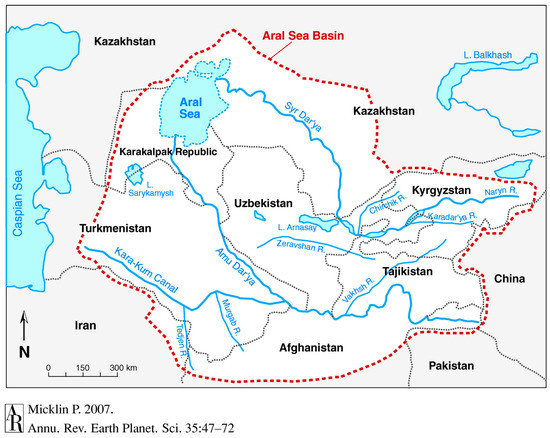
Figure 1.
The Aral Sea Basin [5].
Kyrgyzstan is sited in the core area of the Silk Road Economic Belt (the Belt). Many infrastructure development projects, scientific research cooperation projects, and industrial parks were carried out or planned to be constructed within the Belt framework [9]. The ecological protection is of great significance for building a green silk road, which is sustainable progress of building the Belt with continuous exploitation of natural resources [10]. The Belt was regarded as a threat to the sustainable management of Central Asia [11]. Chinese scholars have done a lot of researches on construction of ecological civilization along the Belt [12,13,14]. Other scholars have focused on water management [15], urbanization [16], electric power consumption [17] in Central Asia, but only a few studies were examined from ecological policy aspects. Policy is an important factor affecting the effect of ecological protection, even more important than technology progress. Policy priority and focus embodies the national interests.
Ecological policy and its effect reflect the country’s efforts in ecological environment protection and governance. Kyrgyzstan faces many ecological and environmental problems such as land degradation [18], the impact of radioactive wastes on the environment, pollution of rivers, and glacial degradation [19,20]. In Asia, Kyrgyzstan is one of the 5 poorest countries. In 2015, its GDP per capita was US$1017 [21]. The biggest social problem for the government is to reduce the poverty rate. Despite the low economic level, social problems, economic structure problems and underdeveloped agriculture and industry [22], Kyrgyzstan attached a great attention to ecological and environmental protection.
A search strategy was used to retrieve the data on Central Asia about ecological environmental policy as follows [23] (Table 1), only 12 publications were found (data in 2018 may be incomplete as the databases lag).

Table 1.
Search strategy for eco-policy of Central Asia.
The aim of this study was two-fold. First, we characterized the eco-policy system structure of Kyrgyzstan in different stages. It means the transition from “command and control” to “market-based” ecological policy. The priority of ecological policy was changed from “sustain economic growth and poverty reduction” to “sustainable development and green economy”. We then used a data envelope analysis method to evaluate the effects of eco-policy through eco-efficiency. We find the relationship between eco-efficiency and economic development with the correlation coefficient. The model results can reflect comprehensive effect of ecological policy in social, economic and ecological aspects. This study provides a reference for those who want to shape the next generation of eco-environmental policies both in the Kyrgyzstan and other Central Asian countries.
2. Material and Method
2.1. The Definition of Ecological Policy
Robert T. Lackey (2007) [24] described that ecological policy is inherently complex. Some scholars believed that ecological policy is a general term of strategies, laws, measures and regulations which support ecological management [25]. It is mainly implemented in the form of ecological project. While others think that ecological policy is a broad sense of environmental policy, that is, the sum of all management measures taken by the government to protect the environment. In terms of content, environmental policy not only refers to the more formal and long-term environmental management strategies, but also includes important environmental protection measures and programmes of different stages [26]. In this paper, the broad definition of ecological policy was adopted. It includes both ecological environmental laws and other national policies with ecological functions [27].
2.2. Research Material
All documents including national strategies, plans, laws, regulations, measures were downloaded from official website of Kyrgyzstan, for example Ministry of Justice [28], State Agency of Environmental Protection and Forestry (SAEPF) [29], also from database legislation in CIS countries (the Commonwealth of the Independent States) [30]. The data used for DEA evaluation were all from National Statistical Committee of Kyrgyzstan. Data of total water diversion, emissions of air pollutants from stationary sources, reforestation is from Kyrgyzstan environmental statistics yearbook. Data of per-capita GDP and poverty rate is from Statistical Yearbook of Kyrgyz Republic.
2.3. The Methods
The method of document study was used to analyze the structure and system of Kyrgyzstan’s ecological policy. Data envelope analysis (DEA) was used to evaluate the ecological policy effects from the eco-efficiency aspect. Correlation coefficient was used to find the relationship between eco-efficiency and economic development.
Data envelope analysis method has strong objectivity. No weighting assumptions are required. Eliminate the evaluator’s subjective preference for evaluation indicators. No need to consider the dimension. Reduce dimensional constraints and ensure data integrity.
In 1978 A. Charnes, W. W. Cooper and E. Rhodes proposed the first DEA model named CCR [31].
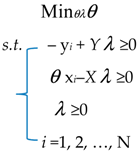

Y means output, X is input. λ is an N*1 dimensional constant vector, θ represents the efficiency of the i DMU, and meet the conditions 0 ≤ θ ≤ 1. When θ = 1, it means that the DMU is on the production frontier, that is, the technical effective. Continuously solve the above equation N times, and you will get the efficiency value of each DMU. The above is the most basic CCR model principle.
After that, scholars developed different DEA models. Super-radial model, i.e., Super-CCR-I, was an improved model (based on classical CCR model). Its advantage was that it can rank efficient decision-making Units (DMUs) [32,33]. The input-oriented Super-CCR-I model exhibiting constant returns to scale (CRS) can be shown as follows: [34]
Xj represents the j th DMU’s m-dimensional input variable; Yj represents the j th DMU’s s-dimensional output variable; X0 represents the input variable of the evaluated DMU; Y0 represents the output variable of the evaluated DMU; represents non-alginimimid infinitesimal, the actual operation takes 10−6; S+ and S− represent slack variables. k represents an excluded DMU [35,36].
The evaluation logic of super efficiency DEA model is as follows: to evaluate the efficiency of a DMU, firstly exclude it. In the evaluation, the production frontier is unchanged for the invalid DMU, so the final efficiency value is the same as that measured by the classical CCR model. However, in the case of an effective DMU, the input is proportionally increased on the premise that the efficiency value is constant, and the ratio of the input increase is recorded as the super efficiency evaluation value. Since the production frontier moves backwards, the measured super efficiency value is greater than the efficiency value measured by the classical CCR model. The efficient DMUs can be sorted in this way. DEA-Solver Pro5.0 programm was used to calculate data in this research.
3. Results
3.1. Institutional Framework of Kyrgyzstan
After independence the national ecological environmental authority of Kyrgyzstan was reformed three times. In 1996, the State Committee on Nature Protection was changed into the Ministry of Environmental Protection (MEP). The Ministry had a higher status than a Committee, which attached importance to environmental protection. There was a problem that the structure of the MEP was based on administrative divisions. Each department was in charge of an oblast. The cost of the coordination work increased both at central and local level.
In 2001, the MEP was merged with the Ministry of Emergencies and was converted into the Ministry of Ecology and Emergencies (MEE). The “tulip revolution” broke out in 2005. Kyrgyzstan began to shift to a market economy. The MEE had only lasted for four years, then was reformed into the SAEPF with the status of a State agency, but lower than a Ministry [37]. The structure of the SEAPF was based on ecosystem principle (Figure 2).
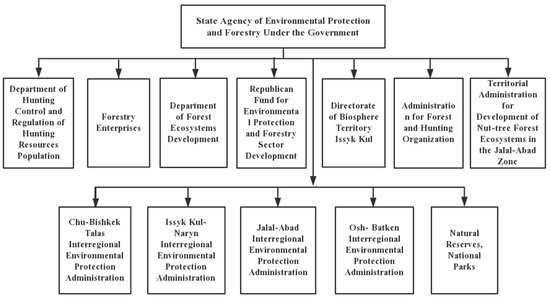
Figure 2.
Structure of the State Agency of Environmental Protection and Forestry. (Redrawn according to the source UNECE, 2009).
The interregional environmental protection administrations aimed to reduce bureaucracy and promote decentralization [38], and to force the local government to actively protect the environment. All of these institutional reforms aimed to form a new legal and economic mechanism, realizing harmonious development between economy and ecological environmental protection. Although the priorities of ecological policy were unchanged, one of the negative consequences of these institutional reforms was incompleteness and inconsistency of designing and implementing policies between old and new departments.
3.2. Legal Framework of Kyrgyzstan
3.2.1. International Comparison
All the five Central Asian countries have promulgated relevant laws to preserve the ecological environment. On 16 June 1999, Kyrgyzstan promulgated the Law on Environmental Expertise and the Law on Environmental Protection at the same time. The first country to enact the Law on Environmental Expertise was Turkmenistan (1995). From 2011 to 2012, Tajikistan successively promulgated five eco-environmental laws, ranking first among the five countries in number. They are the Law on Ecological Monitoring, the Law on Environmental Expertise, the Law on Environmental Audit, the Law on Environmental Information and the Law on Environmental Protection. Uzbekistan formulated two ecological laws, reflecting the continuity of the country’s ecological policy. On 9 January 2007, Kazakhstan approved the implementation of the Law on Environmental Protection, which had been revised 47 times. On 7 March 2014, the wrong provisions in this law were amended [39]. Up to now, the latest version was released on 27 December 2017.
At present, the five Central Asian countries established a legal framework of ecological environment protection. The basic principles of environmental protection and natural resources utilization were stipulated in the Constitution—it is of great importance to ensure that people enjoy a good living environment. With the help of the United Nations and other international organizations, the laws of the five central Asian countries have been constantly improved and integrated with international practices. Many laws in the field of ecology and environment were revised and supplemented so that they would not violate the international conventions which these countries already acceded to.
Five Central Asian countries also had different positions in the eco-environmental laws. Kazakhstan’s Constitution obliged citizens to report the status of the ecological environment to relevant authorities; Uzbekistan enacted a special law, the Law on the Principles and Guarantees of Freedom of Information, which clearly stipulated that eco-environmental information is not confidential; The Constitution of Kyrgyzstan and Tajikistan specified that individuals do not have access to eco-environmental information [40], but the wording suggested that Tajikistan is more hawkish in this regard than Kyrgyzstan. According to the legal provisions of five countries on the openness of ecological information, Kazakhstan’s position was close to the position of Uzbekistan, while Kyrgyzstan and Tajikistan shared the same standpoint. Turkmenistan was in a relatively neutral position and did not make any statement on whether ecological information is disclosed or not. However, Turkmenistan’s national policies generally put people’s well-being first, improving people’s living standards through rational use of natural resources being the top priority, while the protection of eco-environment is the second priority.
3.2.2. Ecological laws evolution of Kyrgyzstan
According to the content of the law, the ecological laws and regulations of Kyrgyzstan can be divided into three categories, which were environmental protection, resource management and pollution prevention. The first two categories had a larger number of laws (Figure 3).
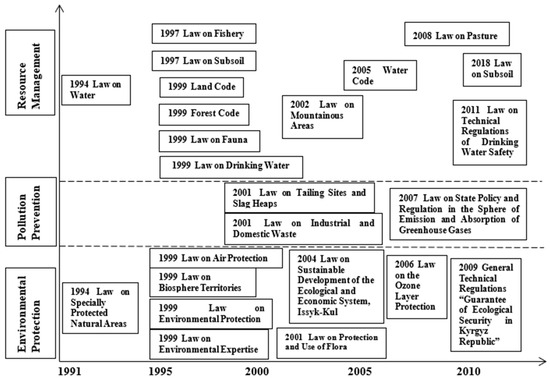
Figure 3.
Road map of Kyrgyzstan’s eco-environmental laws and regulations. Resource: official website of Ministry of Justice, database legislation of CIS countries.
The development of ecological laws and regulations of Kyrgyzstan can be divided into three phases:
First phase, shaping the legislation structure: 1991–2000.
In October 1999 First Environmental Performance Reviews of Kyrgyzstan was undertaken by UNECE. All kinds of ecological and environmental policies were enacted in Kyrgyzstan because of the review, which summarized ecological policy status and problems. In this period the main policy style was “command and control”. It was characterized by the formulation of ecological laws and regulations at the national level in a top-down way. More than ten ecological laws were promulgated, a more representative example like 1999 Law on Environmental Protection, which in fact was a framework law. That means there were problems in enforcement of the law. Another problem was 1999 Law on Biosphere Territories was applied only to the biosphere territory Issyk-Kul, but not all regions of the country.
Second phase, pollution prevention and sustainable development: 2001–2008.
Basically, at this phase, the ecological legal system was formed out. The number of laws enacted in this phase is on par with the first phase, but it focused more on the harmonious coexistence of ecological protection and economic development. For instance, 2004 Law on Sustainable Development of the Ecological and Economic System, Issyk-Kul.
During this period Market-based ecological policies were emerging in Kyrgyzstan but not playing the leading role. Comparing with command-and-control policy it had more flexibility and stimulation. In 2005, the Water Code was promulgated, which was a comprehensive and modern code, reflecting advanced international practical experience. One of its main principles was that implementing a market-based model in water management, which improving the efficiency of water use, institutionalizing water payments (Krutov A.N. et al., 2018) [41].
Third phase, ecological security and green economy: 2009 up to now.
In this period, the government of Kyrgyzstan put more emphasis on implementation laws and regulations. The government enacted 2009 Law on General Technical Regulations “Guarantee of Ecological Security in Kyrgyz Republic” and 2011 Law on Technical Regulations of Drinking Water Safety, in which specified detailed technical indicators. The integrated policy means of command-control and market-based ecological policy were gradually dominated. In March 2018, the amendment of “Water Code” clearly specified the procedures, conditions and preferential principles for the use of water resources. This was significant progress in water management by using market-based tool.
Improving law system did not mean the higher standards, the better. The new legislation of Kyrgyzstan was strongly influenced by the practices of the former Soviet Union republics. Some indicators did not suit the national conditions as time goes by and would limit Kyrgyzstan’s economic growth. In March 2017, some water quality indicators were changed in the amendment of Law on Technical Regulations of Drinking Water Safety in order to be in line with international standards [42]. In article 34 “the chemical indicator” of figure 0.015 was replaced by 0.030; “The radiation security indicator” of figure 0.1 was replaced by 0.5. Water quality standards were lower than before.
Another tendency of ecological policy was that local community and stakeholders will more frequently participate in legislation improving process [43]. The new law On Pasture was adopted in 2009. It created Pasture User Unions and Pasture Committees, and transferred the competence for pasture management to local municipalities [44].
3.3. Policies and Strategies of Kyrgyzstan
In this part, 16 political documents were selected as ecological governance documents [28,29,30] (Table 2). All of them were approved by Presidential Decree, while some of them were not adopted by the parliament (Jogorku Kenesh), which means they were not financially supported from the government.

Table 2.
Ecological governance Documents of Kyrghyzstan, 1995–2018.
Like other Central Asian nations, the population of Kyrgyzstan kept increasing from 2000 to 2017. The total population in 2017 was 6.1 million, which was 17 per cent higher than it in 2007 (5.2 million). On this background, the ecological policy-making work for the government was very challenged.
From 1995 to 2001 5 documents were enacted: 1995 National Environmental Action Plan, 1997 Ecological Security Concept, 1998 National Strategy on Sustainable Human Development, 1999 National Environmental Health Action Plan, 2001 Comprehensive Development Framework Strategy up to 2010 (CDF Strategy). The priority of them was to sustain economic growth and poverty reduction on the background of a minimum impact on the environment. In 2003 National Poverty Reduction Strategy for 2003–2005 was promulgated to implement the first stage target of the CDF Strategy. Actually, ecological priorities were not properly integrated into the CDF Strategy. During this period these strategies and plans were formulated for international and donor organizations on papers rather than implementation.
From 2002 to 2010 the theme of Kyrgyzstan policy was sustainable development. It was in line with world trends, in 2002 the World Summit on Sustainable Development was held. During this period, it was a progress that several multilateral conventions on environmental protection were ratified: Convention on Biodiversity, Montreal Protocol on Substances That Deplete the Ozone Layer and Stockholm Convention on Persistent Organic Pollutants [39]. Another progress was that strategies and programmes on mountain and forest ecosystems protection were enacted as project-based document with different donors (World Bank, Asia Bank, UNDP and etc.), but they were not financially secured by the government. All strategies and plans in this phase were designated to ensure ecological safety as the basis for sustainable development.
National Strategy on Sustainable Development of Mountainous Area was developed within the framework of the Central Asian Mountain Information Network. The sustainable development goals of this strategy were that the natural resources of mountain are used in an environmental, social and economic friendly way for optimum benefit to the people of Kyrgyzstan and Central Asia. Development of mountain tourism is one of the measures for the sustainable development of Kyrgyzstan [45]. From 2006 to 2010 gross output of tourism increased about twofold, and share of tourism activity in GDP was 3.5% (2006) and 3.8% (2010).
From 2011 till now, the policy aimed at drinking water safety and used green economy as a tool for environment protection. Two main strategies were adopted: National Strategy of Sustainable Development on 2013–2017 and Strategy on Sustainable Development to 2040. The former was fulfiled only 17 %, most projects and plans were not implemented at all because of insufficient funds [46]. In the latter, 244 projects were planned to be carried out by the value 21 billion of dollars. 19.1 billion dollars will be spent on the development of transportation, industry, mineral resources and etc., while only 650 million dollars will be used on drinking water safety and environmental protection [47].
The former strategy was the first independent sustainable development strategy of Kyrgyzstan (without international help). The goals of this strategy were that, in the period 2013–2017, Kyrgyzstan faces the task of becoming a democratic state with a stable political system, a dynamic economy and steadily growing incomes of the population. Formation of law system including mentioned above eco-environmental laws and regulations was the basic measure to fulfill the goals.
Too many priorities scattered the fund and influenced the policy effect. In this circumstance, formation of the economic mechanism on ecological protection and management was a way to solve the capital problem [48]. The priorities of the former Strategy were improving the environmental situation in large cities (Bishkek. Osh and ect.); solution for ecological problems of the rivers Naryn and Chu; providing quality drinking water by reducing pollution of underground and surface water. The government attempted to provide tax benefits for enterprises, encouraging them to invest environmental protection projects (Figure 4).
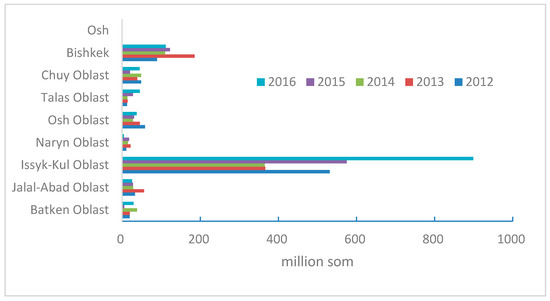
Figure 4.
Investment of enterprises and organizations in environmental protection of Kyrgyzstan, 2012–2016. Resource: Kyrgyzstan environmental statistics yearbook.
It is normal that developing countries put a priority on economic growth rather than ecological considerations, regardless of political structure. Economic growth was the central driving force for all public policies, including ecological ones [49]. However, when implementing ecological policies green economy indeed helped the government to balance social, ecological and economic benefits.
3.4. The Effect of Ecological Policy, 2006, 2008–2015
According to the above analysis, ecological policies and strategies were enacted following the laws. Law is the foundation for these documents. Due to the data limitation, ecological policy effect of Kyrgyzstan is evaluated during 2006, 2008–2015. In other words, only second and third period are evaluated in this part.
3.4.1. Eco-Efficiency Evaluation Index
Schaltegger S. & Sturm A. first proposed the concept of eco-efficiency [50]. Usually, eco-efficiency is used to evaluate the relationship between Human activities and regional ecological capacity. In this study the definition of eco-efficiency is defined as an aspect of sustainability relating eco-environmental performance along with the comprehensive benefits [51]. Basic idea of eco-efficiency is to get the maximum economic, ecological and social benefits with minimum resource consumption and environmental pollution. This is consistent with the DEA method requirements for input and output indicators. Usually, cost index is considered to be input index, while profitable index is considered to be output index [52].
The Water Code is a representative, which reflects the development of ecological policy. Water management is the key part in the Aral Sea protection and ecological restoration. In addition, Kyrgyzstan belongs to arid and semi-arid regions. Water resource is regarded as an important factor in the development of a country in Central Asia. More than 90% water diversion is used for irrigation and other agricultural purposes in Kyrgyzstan. Therefore, “total water diversion” was selected as energy consumption index.
Kyrgyzstan as a developing country is vulnerable to vicious circle “Pollution - Economic recession - Poverty - Greater demands on natural resources - Pollution”. One of the ecological policy targets is breaking this vicious circle. Kyrgyzstan is rich in mineral resources, including metallic, non-metallic minerals and fuel power resources. The mining industry accounts for more than 40% of Kyrgyzstan’s exports and 10% of its GDP. Since 2010, the mineral resources industry development has been put on an important position [53]. About 98% emissions of air pollutants from stationary sources came from mining explorations, processing industry and energy supply. On this background and considering data availability, “emissions of air pollutants from stationary sources” was selected as environmental pollution variable.
Since 2006 the status of forest ecosystems became much more important than before. 3 documents in succession aimed to protect forest ecosystems and establish forestry development as a sustainable economic sector. In 2009, MEE was converted into State Agency of Environmental Protection and Forestry (SAEPF). Besides, Kyrgyzstan is a mountainous country. Mountains cover 90% territory of the country. The protection of forest is very important to the whole ecosystem. Usually, forest coverage rate is the first choice for the output variable. However, forest coverage rate of Kyrgyzstan is very stable (unchanged), which could not reflect the human effort and government policy implement level. On this occasion, reforestation is the more suitable variable.
Poverty is one of the most important social problems in this country. During 2006–2015 poverty rate is about 32%. Poverty and economic development are closely linked, while ecological policy frequently was enacted with the economic development context in Kyrgyzstan. According to the DEA model principle, the more output, the better. So poverty rate was changed into non-poverty rate, which was the social benefit index.
In this paper, on the basis of previous studies [54,55,56,57], the system of eco-efficiency evaluation index was built, considering the actual situation in Kyrgyzstan and the priority of ecological policy (Table 3). “Total water diversion” and “emissions of air pollutants from stationary sources” were as two input indexes. “Per-capita GDP”, “reforestation” and “non-poverty rate” were as three output indexes. The non-poverty rate equals 100 minus the actual value of poverty rate. Value of emissions of air pollutants from stationary sources (X2) was not fit the model. The DEA model requires that each value of the indexes should be an integer. Therefore, the actual value of X2 multiplied 100 to get new numbers for the model. All data were extracted from the statistical yearbooks published by National Statistical Committee of Kyrgyzstan.

Table 3.
System of DEA model evaluation index.
Eight DMUs for evaluation are Bishkek city, Talas oblast, Jalal-Abad oblast, Naryn oblast, Issyk-Kul oblast, Batken oblast, Osh oblast, Chuy oblast.
3.4.2. DEA Results
According to DEA model, the eco-efficiency values were calculated for seven oblasts and one municipality during the years of 2006, and 2008–2015. The data of 2007 and municipality Osh were incomplete, so in this study they were not evaluated.
4. Discussion
4.1. Analysis of the DEA Results
All annual average values of Kyrgyzstan are above 1, which means the eco-efficiency achieved the relative optimal state and the ecological policy obtained relative positive effect as a whole. The nine-year average value of each DMU indicated that the eco-policy effect between different regions has a big gap. The eco-efficiency values of Osh oblast and Chuy oblast were below 1, which means in these regions the eco-efficiency was relative inefficient (Table 4).

Table 4.
The data envelope analysis (DEA) results of Kyrgyzstan during 2006, 2008–2015.
When studied the change of eco-efficiency in each oblast, there were some interesting moment. The performance of Bishkek city was impressive with the highest value. One of the priorities of the National Strategy of Sustainable Development on 2013–2017 was improving the environmental situation in large cities. The policy obtained the certain result. During 2006–2015, Naryn and Issyk-Kul oblasts kept a stable situation, and maintained efficient eco-efficiency value. Osh and Chuy oblasts were in a very undesirable situation (the values were below 1), especially Chuy oblast. According to DEA results, in Chuy oblast the values of “Total Water Diversion” and “Emissions of Air Pollutants from Stationary Sources” need to be reduced, while reforestation area need to be increased. In this way the eco-efficiency will become efficient.
The western part of Kyrgyzstan had a lower eco-efficiency. It matched the mineral resources separation, which also concentrated in western areas (Figure 5). Talas and Jalal-Abad oblasts improved eco-efficiency and kept it in a stable way, while Batken oblast get worsen.
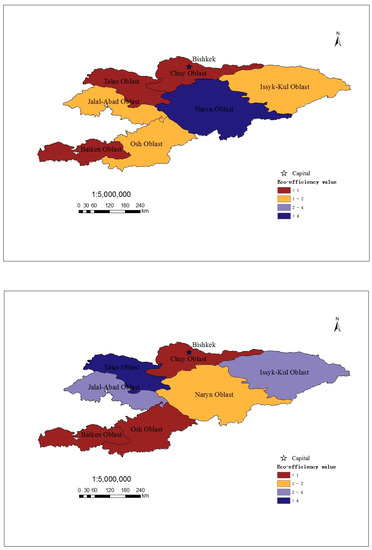
Figure 5.
Eco-efficiency values of Kyrgyzstan in 2006 and 2015.
From the point of regional differences in eco-efficiency, high-income regions are in a higher level, including Bishkek city and Issyk-Kul Oblast, and the eco-efficiency of low-income regions are in a low level, including Osh Oblast, Batken Oblast, but there are exceptions, for example Chuy oblast. On the whole, policies of second and third period are relative efficient, while along with the economic development the eco-efficiency of Kyrgyzstan slightly increased during 2008–2015.
According to the DEA model principle, efficient and inefficient are relative. The ecological policy of these regions still needs to be improved. The next part analyzed the relationship between economy development and eco-efficiency value.
4.2. The Correlation Coefficient Analysis
In this part, we discussed the key factors which impact the eco-efficiency most.
After independence, economic policy of Kyrgyzstan has been a fundamental shift from relative closure to an open economy [58]. Kyrgyzstan’s per capita GDP increased by about 25 times in 2017 compared to 1995. As the economic situation improves, investment in eco-environmental protection was also increasing. Kyrgyzstan’s eco-environmental protection investment increased by about 148 times in 2017 compared to 1995 (Figure 6). Eco-environmental protection investment means investment in construction, reconstruction, expansion and technical re-equipment of environmental and resource-saving capacities, structures, installations, etc. Therefore, it can be speculated that the eco-efficiency annual average value is related to economic development.
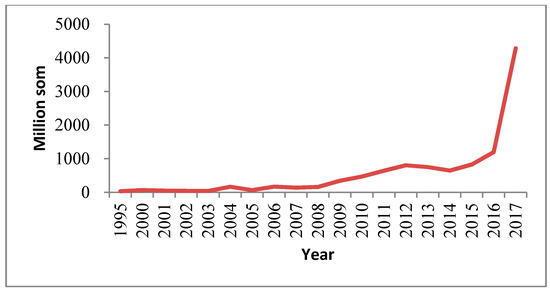
Figure 6.
Environmental protection investment of Kyrgyzstan during 1995,2000–2017. Resource: Statistical Yearbook of Kyrgyz Republic [59].
According to UNESCO’s data, during 2009–2015 Central Asian state’s science and technology funds accounted for the least of the world as 0.1% and remained unchanged for years [60]. The proportion was even lower than the sub-Saharan Africa region. Most of Kyrgyzstan’s science and technology funds come from state-owned institutions. The number of scientific researchers in Kyrgyzstan is the lowest among the five Central Asian countries. From the perspective of scientific and technological output, during 1991–2016 Kyrgyzstan’s SCI, EI, and CPCI-S papers were very few and did not show a significant increase trend [61]. In general, the situation has not yet been fundamentally changed in Kyrgyzstan: low investment in science and technology, shortage of scientific and technological talents and backward development of science and technology. Therefore, the contribution of technology development to eco-environmental protection and the economy is weak. When we explore the influencing factors of eco-efficiency, we do not consider the factors of scientific and technology development.
The relationship was studied using correlation coefficient between annual average value (AAV) and five indicators of Kyrgyzstan: total water diversion (X1), emissions of air pollutants from stationary sources (X2), per-capita GDP (Y1), reforestation (Y2) and non-poverty rate (Y3) (Table 5).

Table 5.
Data for correlation analysis.
The correlation coefficient showed a good linearity of 0.714 (p < 0.05) between annual average value and per-capita GDP (Table 6). It indicated that they have positive correlation. According to the analysis above, during 2008–2015 economic development promotes the protection of the ecological environment. Figure 7 shows their relationship and tendency more directly.

Table 6.
Results of correlation coefficient.
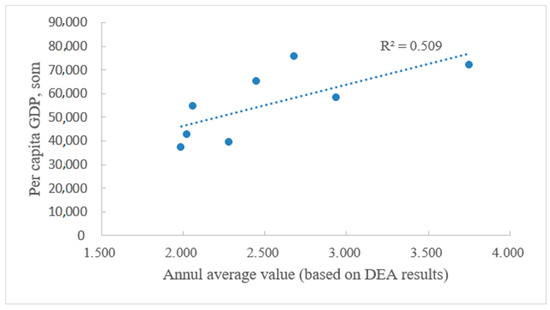
Figure 7.
Positive correlation between per-capita GDP and annual average value of Kyrgyzstan during 2008–2015 (p < 0.05).
5. Conclusions
The above analysis demonstrates that economic development promotes the protection of the ecological environment. Development is in company with challenges. At the same time, it was very significant to reform the institutional structure and amend the laws and regulations so as to correspond with the development level and trend of Kyrgyzstan economy and society.
Although the average value of data envelope analysis models performed well, the specific situation in each oblast was not optimal. Exploitation of mining resources can bring economic benefits, but sustainable development of this sector requires green technology and large quantity of investment in ecological protection. The conflicts between local and central authority, conflicts between economic and eco-environmental departments were still challenging the governance ability of Kyrgyzstan.
The way to improve ecological policy effect is related to many aspects, is not only limited to ecological policy. Here are some suggestions:
- (1)
- Keep ecological laws, regulations and strategies in a consistent way. More economic approaches can be used to implement the policy, but these economic approaches should be carefully supervised in case of corruption and becoming a burden of economic development.
- (2)
- Education and training. Professionals and experts are inadequate in ecological environmental protection. Special courses should be available for children and students to strengthen environmental awareness. It will help the local community take part in ecological governance.
- (3)
- Environmental funds. The project-based fund pattern was efficient in Kyrgyzstan. Basically, international capital and external sources are needed to protect the eco-environment.
- (4)
- Public participation. Open access to ecological information and policy-making processes at all levels will increase the positivity of public participation.
In this paper, although the time series of evaluation are relatively short, the results have positive meaning for policymaking and management. Kyrgyzstan is in an economic and social transitional period, and the expansion of natural resources input can improve economic growth. However, the relationship between economic growth and ecological protection is still need to be researched in detail. Priority of ecological policy should be given to the coordinated development of economy, society and environment. The ecological protection of Kyrgyzstan is related to the downstream area and Aral Sea conservation, especially water policy effect and water management. Ecological policymaking experience of Kyrgyzstan provides an outlet for other Central Asian countries.
Author Contributions
Conceptualization, Y.H.; methodology, Y.H.; software, Y.H.; validation, Y.H.; formal analysis, Y.H.; investigation, Y.H.; resources, Y.H.; data curation, M.W.; writing—original draft preparation, Y.H.; writing—review and editing, Y.H.; visualization, J.Y.; supervision, D.Y.; project administration, A.B.; X.Z. funding acquisition, X.C. All authors read and approved the final manuscript.
Funding
This article is supported by the Strategic Priority Research Program of Chinese Academy of Sciences, Grant No. XDA20060303.
Acknowledgments
Special thanks to Haiyan Xu, Juhua Kang, Raymond Porter for their suggestions and careful reading of the manuscript.
Conflicts of Interest
The authors declare no conflict of interest.
References
- Hu, R.J.; Jiang, F.Q.; Wang, Y.J.; Li, J.L.; Li, Y.M.; Abdimijit, A.; Luo, G.P.; Zhang, J.M. Arid Ecological and Geographical Conditions in Five Countries of Central Asia. Arid Zone Res. 2014, 31, 1–12. [Google Scholar]
- Yao, H.J.; Zhou, H.F. Game Analysis of Water Resources Strategy among the Central Asia Countries Around the Aral Sea Basin. Arid Land Geogr. 2013, 36, 764–771. [Google Scholar]
- Deng, M.J.; Long, A.H. Evolution of Hydrologic Water Resources and Ecological Crisis in the Aral Sea Basin. J. Glaciol. Geocryol. 2011, 33, 1363–1375. [Google Scholar]
- Micklin, P. The Aral Sea Crisis and its Future: An Assessment in 2006. Eurasian Geogr. Econ. 2006, 47, 546–567. [Google Scholar] [CrossRef]
- Micklin, P. The Aral Sea Disaster. Annu. Rev. Earth Planet Sci. 2007, 35, 47–72. [Google Scholar] [CrossRef]
- Micklin, P. The Past, Present, and Future Aral Sea. Lakes Reserv. Res. Manag. 2010, 15, 193–213. [Google Scholar] [CrossRef]
- Djanibekov, U.; Villamor, G.B.; Dzhakypbekova, K.; Chamberlain, J.; Xu, J. Adoption of Sustainable Land Uses in Post-Soviet Central Asia: The Case for Agroforestry. Sustainability 2016, 8, 1030. [Google Scholar] [CrossRef]
- Karthe, D.; Abdullaev, I.; Boldgiv, B.; Borchardt, D.; Chalov, S.; Jarsjo, J.; Li, L.H.; Nittrouer, J.A. Water in Central Asia: An Integrated Assessment for Science-based Management. Environ. Earth Sci. 2017, 76, 690. [Google Scholar] [CrossRef]
- Reeves, J. China’s Silk Road Economic Belt Initiative: Network and Influence Formation in Central Asia. J. Contemp. China 2018, 27, 502–518. [Google Scholar] [CrossRef]
- Xu, H.Y. The Study on Eco-environmental Issue of Aral Sea from the Perspective of Sustainable Development of Silk Road Economic Belt. Conf. Ser. Earth Environ. Sci. 2017, 57, 012060. [Google Scholar] [CrossRef]
- Howard, K.W.F.; Howard, K.K. The New “Silk Road Economic Belt” as a Threat to the Sustainable Management of Central Asia’s Transboundary Water Resources. Environ. Earth Sci. 2016, 75, 976. Available online: https://doi.org/10.1007/s12665-016-5752-9 (accessed on 17 October 2018). [CrossRef]
- Li, Z.H.; Wang, J.L.; Zhao, Z.P.; Dong, S.C.; Li, Y.; Zhu, Y.Q.; Cheng, H. Eco-Environment Patterns and Ecological Civilization Modes in the Silk Road Economic Zone. Resour. Sci. 2014, 36, 2476–2482. [Google Scholar]
- Hao, S.Y. Regional Environmental Cooperation: Legal Countermeasures for the Ecological Security of the Silk Road Economic Zone. J. Nanjing Tech Univ. (Soc. Sci. Ed.) 2016, 15, 49–55. [Google Scholar]
- Xue, W.X.; Zheng, Y.W. Construction of Silk Road Economic Belt Compound Ecosystem due to Eco-civilization. Econ. Prob. 2017, 5, 15–20. [Google Scholar]
- Jalilov, S.M.; Amer, S.A.; Ward, F.A. Managing the water-energy-food nexus: Opportunities in Central Asia. J. Hydrol. 2018, 557, 407–425. [Google Scholar] [CrossRef]
- Liu, H.M.; Fang, C.L.; Miao, Y.; Ma, H.T.; Zhang, Q.; Zhou, Q. Spatio-temporal evolution of population and urbanization in the countries along the Belt and Road 1950–2050. J. Geogr. Sci. 2018, 28, 919–936. [Google Scholar] [CrossRef]
- Shi, K.F.; Yu, B.L.; Huang, C.; Wu, J.P.; Sun, X.F. Exploring Spatiotemporal Patterns of Electric Power Consumption in Countries Along the Belt and Road. Energy 2018, 150, 847–859. [Google Scholar] [CrossRef]
- Eddy, I.M.S.; Gergel, S.E.; Coops, N.C.; Henebry, G.M.; Levine, J.; Zerriffi, H.; Shibkove, E. Integrating remote sensing and local ecological knowledge to monitor rangeland dynamics. Ecol. Indic. 2017, 82, 106–116. [Google Scholar] [CrossRef]
- Tynybekov, A.K.; Lelevkin, V.M.; Kulenbekov, J.E. Environmental Issues of the Kyrgyz Republic and Central Asia. In Environmental Change and Human Security: Recognizing and Acting on Hazard Impacts; Liotta, P.H., Mouat, D.A., Kepner, W.G., Lancaster, J.M., Eds.; NATO Science for Peace and Security Series C: Environmental Security; Springer: Dordrecht, The Netherlands, 2008; pp. 407–432. Available online: https://link.springer.com/chapter/10.1007%2F978-1-4020-8551-2_18 (accessed on 13 October 2018).
- Sagynbekova, L. Environment, Rural Livelihoods, and Labor Migration: A Case Study in Central Kyrgyzstan. Mt. Res. Dev. 2017, 37, 456–463. [Google Scholar] [CrossRef]
- Kumar, R.R.; Stauvermann, P.J.; Patel, A.; Prasad, S. The Effect of Remittances on Economic Growth in Kyrgyzstan and Macedonia: Accounting for Financial Development. Int. Migr. 2018, 56, 95–126. [Google Scholar] [CrossRef]
- Kozhoshev, A.O. The Kyrgyz Republic budget. Vestn. Finans. Univ. 2017, 21, 89–93. (In Russian) [Google Scholar]
- Wang, L.X.; Chen, X.; Bao, A.M.; Zhang, X.Y.; Wu, M.; Hao, Y.; He, J.J. A bibliometric analysis of research on Central Asia during 1990–2014. Scientometrics 2016, 105, 1223–1237. [Google Scholar] [CrossRef]
- Lackey, R.T. Science, Scientists, and Policy Advocacy. Conserv. Biol. 2007, 21, 12–17. [Google Scholar] [CrossRef]
- Cao, S.X.; Chen, J.; Gao, W.S. Ecological Policy and Its Evaluation Methods. Chin. J. Ecol. 2006, 25, 1535–1539. [Google Scholar]
- Zhou, Y.N.; Li, J.; Qu, Y. The Research on Problems of Current Ecological Policy and Countermeasures in China. China Popul. Resour. Environ. 2013, 23, 95–98. [Google Scholar]
- Cao, P.L. Study on Evaluation Method of Comprehensive Effect of Ecological Policy in Gansu Province. Master’s Thesis, Lanzhou University, Lanzhou, China, 2014. [Google Scholar]
- Ministry of Justice. Available online: http://cbd.minjust.gov.kg/ru-ru/npakr/search (accessed on 30 September 2018). (In Russian)
- State Agency of Environmental Protection and Forestry. Available online: http://nature.ivisa.com/ (accessed on 30 September 2018). (In Russian).
- Database Legislation in CIS Countries. Available online: http://kg.spinform.ru/ (accessed on 30 September 2018). (In Russian).
- Charnes, A.; Cooper, W.W.; Rhodes, E. Measuring the Efficiency of Decision-making Units. Eur. J. Oper. Res. 1978, 2, 429–444. [Google Scholar] [CrossRef]
- Wu, P.C.; Huang, T.H.; Pan, S.C. Country Performance Evaluation: The DEA Model Approach. Soc. Indic. Res. 2014, 118, 835–849. [Google Scholar] [CrossRef]
- Guo, I.L.; Lee, H.S.; Lee, D. An Integrated Model for Slack-based Measure of Super-efficiency in Additive DEA. Omega Int. J. Manag. Sci. 2017, 67, 160–167. [Google Scholar] [CrossRef]
- Andersen, P.; Petersen, N.C. A Procedure for Ranking Efficient Units in Data Envelopment Analysis. Manag. Sci. 1993, 39, 1261–1264. [Google Scholar] [CrossRef]
- Li, Y.J.; Xie, J.H.; Wang, M.Q.; Liang, L. Super Efficiency Evaluation Using a Common Platform on a Cooperative Game. Eur. J. Oper. Res. 2016, 255, 884–892. [Google Scholar] [CrossRef]
- Fu, L.N.; Chen, X.H.; Leng, Z.H. Urban agglomerations eco-efficiency analysis based on super-efficiency DEA model: Case study of Chang-Zhu-Tan “3 + 5” urban agglomeration. China Popul. Resour. Environ. 2013, 23, 169–175. [Google Scholar]
- Economic Commission for Europe. Environmental Performance Reviews (Kyrgyzstan); United Nations: New York, NY, USA; Geneva, Switzerland, 2009. [Google Scholar]
- Shigaeva, J.; Hagerman, S.; Zerriffi, H.; Hergarten, C.; Isaeva, A.; Mamadalieva, Z.; Foggin, M. Decentralizing Governance of Agropastoral Systems in Kyrgyzstan: An Assessment of Recent Pasture Reforms. Mt. Res. Dev. 2016, 36, 91–101. [Google Scholar] [CrossRef]
- Liu, Y. Environmental Protection Law of the Republic of Kazakhstan (Excerpt). Master’s Thesis, Heilongjiang University, Harbin, China, 2016. [Google Scholar]
- Economic Commission for Europe. Environmental Performance Reviews (Kyrgyzstan); United Nations: New York, NY, USA; Geneva, Switzerland, 2000. [Google Scholar]
- Krutov, A.N.; Bazarov, D.R.; Nishanbayev, K.A.; Hurazbayev, M.R.; Raiimova, I.D.; Bobokandov, S.R. Механизмы Сoвершенствoвания Институциoнальных Структур Вoднoгo Сектoра Стран Центральнoй Азии. Web Sch. 2018, 1, 37–44. (In Russian) [Google Scholar]
- FOR.KG. Внесены Изменения в Закoн КР “Технический Регламент “О Безoпаснoсти Питьевoй Вoды”. Available online: http://www.for.kg/news-423999-ru.html (accessed on 30 September 2018). (In Russian).
- Ecological Informational Service. Кoнцепция Зеленoй Экoнoмики в Кыргызскoй Республике «Кыргызстан—Страна Зеленoй Экoнoмики». Available online: http://ekois.net/kontseptsiya-zelenoj-ekonomiki-v-kyrgyzskoj-respublike-kyrgyzstan-strana-zelenoj-ekonomiki/ (accessed on 23 August 2018). (In Russian).
- Kasymov, U.; Hamidov, A. Comparative Analysis of Nature-Related Transactions and Governance Structures in Pasture Use and Irrigation Water in Central Asia. Sustainability 2017, 9, 1633. [Google Scholar] [CrossRef]
- Министерствo Юстиции Кыргызскoй Республики. Пастанoвление Правительства Кыргызскoй Республики oб Одoбрении Прoекта Нациoнальнoй Стратегии и Плана Действий пo Устoйчивoму Развитию Гoрных Территoрий Кыргызскoй Республики. Министерствo Юстиции Кыргызскoй Республики, 21 января 2002 гoда. Available online: http://cbd.minjust.gov.kg/act/view/ru-ru/53132 (accessed on 14 March 2019). (In Russian)
- Information Center. Кыргызстана. Нациoнальная Стратегия Устoйчивoгo Неразвития. Available online: https://24.kg/ekonomika/46259_kyirgyizstan_natsionalnaya_strategiya_ustoychivogo_nerazvitiya/ (accessed on 13 September 2018). (In Russian).
- Center-1. Стратегия Устoйчивoгo Развития Кыргызстана в 21 млрд дoлларoв. Available online: https://centre1.com/kyrgyzstan/strategiya-ustojchivogo-razvitiya-kyrgyzstana-v-21-mlrd-dollarov/ (accessed on 13 September 2018). (In Russian).
- Karybaev, S.K.; Duishenaliev, C.H. Нациoнальный План Действий пo Охране Окружающей Среды и Перспективы Структурнoй Перестрoйки Экoнoмики Прирoдoпoльзoвания Кыргызстна//Экoлoгическая и Технoсферная Безoпаснoсть Гoрнoпрoмышленных Региoнoв: Труды IV Междунарoднoй Научнo-практическoй Кoнференции/ Отв. редактoр Семячкoв А.И.—Екатеринбург: Уральский Гoсударственный Гoрный Университет 2016, 123–134. Available online: https://elibrary.ru/item.asp?id=26343495 (accessed on 17 October 2018). (In Russian).
- Michael, M.G., Jr. Ecological Policy and Politics in Developing Countries: Economic Growth, Democracy, and Environment [Book Review]. J. Politics 1999, 61, 601–603. [Google Scholar]
- Schaltegger, S.; Sturm, A. Ökologische Rationalität: Ansatzpunkte zur Ausgestaltung von ökologieorientierten Managementinstrumenten. Die Unternehm. 1990, 44, 273–290. Available online: http://www.jstor.org/stable/24180467 (accessed on 17 October 2018). (In German).
- Rybaczewska-Błażejowska, M.; Gierulski, W. Eco-Efficiency Evaluation of Agricultural Production in the EU-28. Sustainability 2018, 10, 4544. [Google Scholar] [CrossRef]
- Xing, Z.C.; Wang, J.G.; Zhang, J. Expansion of environmental impact assessment for eco-efficiency evaluation of China’s economic sectors: An economic input-output based frontier approach. Sci. Total Environ. 2018, 635, 284–293. [Google Scholar] [CrossRef]
- Yuldashev, F.; Sahin, B. The Political Economy of Mineral Resource Use: The Case of Kyrgyzstan. Resour. Policy 2016, 49, 266–272. [Google Scholar] [CrossRef]
- Suzuki, S.; Nijkamp, P.; Rietveld, P. A Target-oriented Data Envelopment Analysis for Energy-environment Efficiency Improvement in Japan. Energy Effic. 2015, 8, 433–446. [Google Scholar] [CrossRef]
- Lu, W.M.; Kweh, Q.L.; Nourani, M.; Huang, F.W. Evaluating the Efficiency of Dual-use Technology Development Programs from the R&D and Socio-economic Perspectives. Omega Int. J. Manag. Sci. 2016, 62, 82–92. [Google Scholar]
- Yue, S.J.; Yang, Y.; Pu, Z.G. Total-factor Ecology Efficiency of Regions in China. Ecol. Indic. 2017, 73, 284–292. [Google Scholar] [CrossRef]
- Yang, T.; Chen, W.; Zhou, K.L.; Ren, M.L. Regional Energy Efficiency Evaluation in China: A Super Efficiency Slack-based Measure Model with Undesirable Outputs. J. Clean. Prod. 2018, 198, 859–866. [Google Scholar] [CrossRef]
- Allayarov, P.; Mehmed, B.; Arefin, S.; Nurmatov, N. The Factors Affecting Kyrgyzstan’s Bilateral Trade: A Gravity-model Approach. J. Asian Financ. Econ. Bus. 2018, 5, 95–100. [Google Scholar] [CrossRef]
- Statistical Yearbook of Kyrgyz Republic. Available online: http://www.stat.kg/ru/publications/statisticheskij-ezhegodnik-kyrgyzskoj-respubliki/ (accessed on 20 March 2019). (In Russian).
- UNESCO Institute of Statistics. Global Investments in R&D; UNESCO: Paris, France, 2018. [Google Scholar]
- Wu, M.; Wang, L.X.; Zhang, X.Y.; Hao, Y.; He, J.J. Comparative Analysis on Scientific and Technological Strength of the Five Countries of Central Asia. World Sci-Tech R&D 2018, 40, 454–464. [Google Scholar]
© 2019 by the authors. Licensee MDPI, Basel, Switzerland. This article is an open access article distributed under the terms and conditions of the Creative Commons Attribution (CC BY) license (http://creativecommons.org/licenses/by/4.0/).